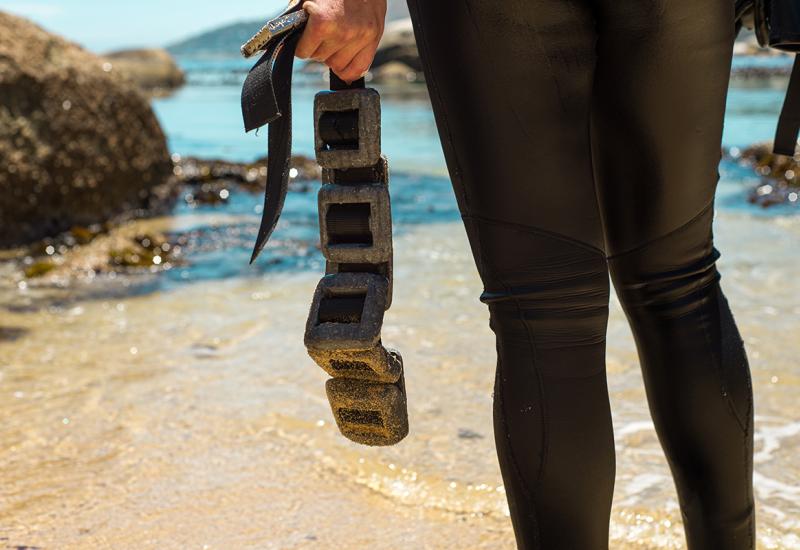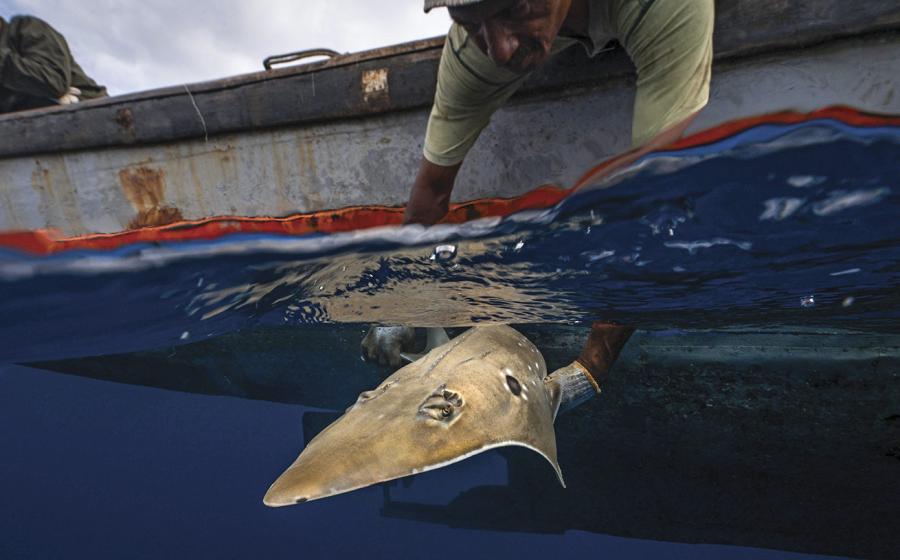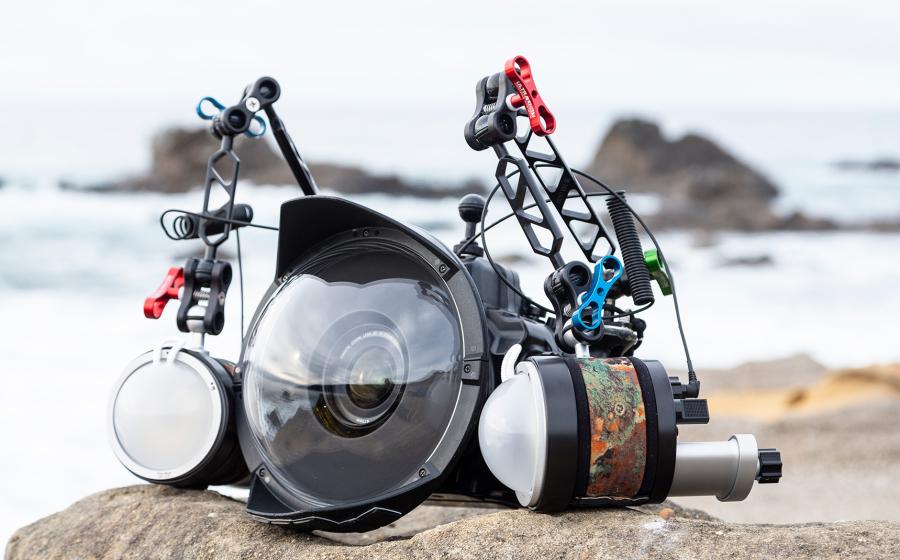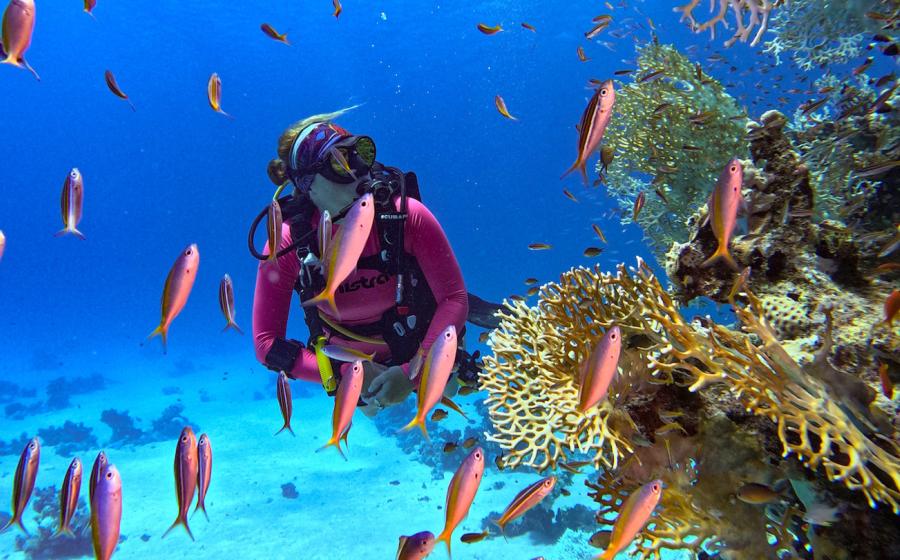Boat Smarts
By John Francis
Photography by Stephen Frink
||
|---|
|  |
|
| Listen up: A good crew will outline procedures specific to the boat you're diving from.|
A dive resort's "commuter" boat, smaller than a live-aboard boat, smaller (usually) than the day-long charter boats, has its own routines and requirements, discomforts and dangers. Wondering what you've signed up for, sailor? Relax. The boat ride to the dive site can be safe, easy and almost fun. In fact, it's a lot like the commercial airline flight that probably carried you to your destination. The resort's dive boat is not quite a floating 737, but there are parallels. Just do this:
Hurry Up and Wait
It seems so simple-just grab your stuff from your gear locker and jump on the boat-that you should be able to put it off until the last minute. But that's not how it works at the airport or the boat dock either. The last minute is when you discover you left your sunscreen in your room or you need a new battery for your dive computer. Now you're rushing to make the boat, which, like Flight 1045, probably won't wait for you. If it does, you'll have to board under the hostile fire of impatient divers.
On the other hand, getting to airports and gear lockers ridiculously early gives you time to move slowly, stay cool, think through what you're doing and, if necessary, run back to your room for the battery. Since divers don't yet have to wait in a long security line before boarding the boat, you don't have to be quite so ridiculously early. Thirty minutes should be enough.
Limit Your Carry-on
||
|---|
|  |
|
| After you assemble your gear, stow your carry-on under your gear station.|
Take with you on the boat only what you'll need for the next few hours, leaving the rest of the week's stuff in your gear locker. In that sense, the locker is like checked luggage, with the added benefit that it does not fly to Newark while you're out diving. Wear your bulky BC and carry your mask, fins, snorkel, regs, instruments and wetsuit in one carry-on bag. If you can't carry everything necessary from locker to boat in one trip, you've probably got too much, though photographers get an extra baggage allowance.
Wait for the Boarding Announcement
Skippers are strangely territorial about their domains. To them, boarding without permission is like walking into a house without knocking. And sometimes the crew needs to service the craft-to wash down decks or lift hatches before you clutter up the area. Ask, "OK to board?" before you do. It's the nautical equivalent of the boarding pass.
Take a Seat
As on budget airlines, dive boat seating is usually first-come first-served, but after you've grabbed the same prime spot several times in a row, the other divers will usually concede it to you. That's another benefit of being early.
Where's the best gear station? There are trade-offs: Closest to the stern means the least walking between bench and water, and there's the least up-and-down motion. But there's the most noise and smell at the back, usually no shade and a fair amount of spray. The extreme bow is often uncrowded, but wet and wild. Mid-ship under shade and not too far from the side entrances is a good compromise-like the emergency exit rows on an airplane.
Check Around You
||
|---|
|  |
|
| Check the pressure in your tank early, in case you get a short fill.|
Got everything you'll need? As soon as possible, assemble your regs and BC on a tank and check them out. If a piece of gear fails to report or refuses its duty, you still have a hope of replacement before the boat leaves the dock. Check the air pressure in your tank; it seems there's always one with a short fill.
Secure Personal Items Before Departure
Once BC and regs are mounted on your tank, reattach the bungee or whatever secured it. Never leave a tank standing by itself for a second. Put weights under your seat, or they may land on someone's toe, maybe yours. Your carry-on bag goes under your seat, which is no bigger than an airliner seat. If the boat is full, there won't be extra room. Your bag needs to be small and compressible to fit under your seat. A bag that sticks out blocks the aisle for other passengers and may not be allowed.
Listen to the Safety Briefing
Among the complaints of flight attendants and dive guides, "They don't listen to the briefing" is near the top of the list. Your dive guide complains because he has to go looking for you when you get lost, and you got lost because you didn't hear him tell you the boat is moored in 20 feet of water, the reef drops off to the east and the current runs north to south. If you get separated from everyone else, that's all the information you need to find the boat. You're much more likely to need that information than the fact that your seat cushion is a flotation device, so pay attention.
Get Comfortable
Most places we dive are hot and humid. Wearing your wetsuit during the boat ride promotes sweating and dehydration, which elevates your risk of DCS. Odds are you're going to get more than enough sun before the week is over too. Take it in small doses and stay under shade or under a hat during the boat ride. Drink water. When the engine slows down, the boat is approaching the mooring. That's the time to zip up, not before.
Prepare To "Deboat"
When it's time to get wet, wear everything but fins and mask. Your mask should be around your neck, not on your face because body heat from your face will fog it. Don't try to walk in your fins. Those gunboats on your feet jam up the passageway, tangle with other divers' shins and expose you to a slip-and-fall for which there's no one to sue but yourself. Remember, small boats have a quick motion, and unlike airplanes, all boats rock and roll more when they're moored than when they're running. Carry both fins in one hand so the other is free to hang on. Is your air on? Computer on?
At the door, put on mask and fins and step off. Go one at a time after acknowledgment by the divemaster, who should want to check you off his list. Like a flight attendant, he'll be there to steady you if you stumble on the threshold. If you found a seat near the exit and geared up promptly, you can be one of the first in the water. Now you have the time you need to make surface adjustments, descend as slowly as your ears require and not lose the rest of the group.
Orient Yourself
Double-check the briefing. What does your depth gauge say at the mooring block under the boat? Which way does the current run relative to the slope of the bottom? If you get lost, you can always find the boat by following the bottom contour to the mooring, assuming you know whether to go up-current or down-current. (No current? Put shallow water to left or right when outbound, reverse it when returning.)
Reboard the Boat
||
|---|
|  |
|
| Make sure you have a hand on the ladder before removing either fin.|
After a pleasant dive comes the return to the boat and the most difficult and dangerous thing you may do all day: climbing the ladder. You're tired, and the ladder chops up and down and moves from side to side as the boat swings on its mooring. Either motion can increase suddenly when the wake of a passing boat hits or your boat turns to the swell, and don't think you can protect yourself by pushing off with your hand. Approach the ladder below the surface so you can see it. Don't chase its side-to-side motion; let it come back to you. Don't get under it, under the boat, or near the props; the blades are sharp.
The usual drill is to take off your fins in the water, pass them up to crew, then climb the ladder. But different boats have different routines. If you can, also take off weights and tanks in the water-the climb will be safer and will generate fewer nitrogen bubbles. Don't take off either fin until you have a hand on the ladder.
After you collect your fins and whatever other gear you've passed up, go to your seat, remove everything heavy and sit down. The surface interval is really another decompression stop, and you should rest to offgas smoothly and avoid generating bubbles. Lie down if you want, but don't sleep; that slows your circulation too much. The surface interval is when the snack and beverage cart is likely to appear. Take anything offered; your levels of both fuel and water are lower than you think.
Stay Warm
||
|---|
|  |
|
| Don't pass up the chance to refuel with onboard refreshments.|
Wind on wet neoprene is like a swamp cooler, and it's easy to get colder on the boat than in the water. This is the wrong time to get cold, because it constricts your circulation and slows your offgassing of nitrogen. So take off your wetsuit and towel off, or protect your suit from the wind with a dive coat or wind breaker, or at least wipe the extra water from the outside of your wetsuit to reduce evaporative cooling.
Now you're on your way back to the dock. Once you get there, don't jump up too soon. You may be as eager to get off the boat as out of a plane, but flight attendants and divemasters have the same reasons for trying to restrain your eagerness: a final lurch could throw you off your feet. Check around you for personal items. And say thank you to the crew. They may be passing out life jackets someday.
The Ideal Resort Boat
The resort's dive boat is really more like a city bus than an Airbus: intended for short trips with minimum comfort, maximum carrying capacity and easy entrance and exit for mobility-challenged passengers. Expect handholds and railings everywhere, wide ladders, big dive platforms and a short step from there up to the deck, which should have some kind of nonskid surface.
Resort dive boats are typically between 30 and 50 feet long. Bigger is better for stability. There will be a long bench along each side with tank racks behind and gear stowage below. The best have twin engines (for redundancy, not speed), shade awnings, drinking water, two-way radios and emergency oxygen. In the tropics, few have toilets, something you might consider before bringing your dry suit.
The crew is at least as important as the equipment. The captain needs to stay aboard while you dive, to deal with changing weather, dragging anchor, etc. If the boat is gone when you surface, it will not be funny. A deckhand should take your weights and fins and help you up the ladder. You tip for that service, not for driving the boat and tying dock lines.
Besides a dive-site briefing there should be a boat briefing. A safe operation tells you where life jackets and first-aid equipment are and, most important, it formally and audibly checks divers into and out of the water. An eyeball count really isn't good enough.
Seasickness Secrets
Some of us are more prone to seasickness than others, but nobody is immune. A few truths apply to all:
Prevention is better than treatment. Once you feel nausea, there's not much you can do. What you should have done is gotten ahead of the problem. Take seasickness meds before you board the boat, not when you feel queasy. You might even begin taking the pills the night before, to build up a level of the stuff in your system.
Eat. You'll do better with something on your stomach. Make it bland, like bread or cereal and go easy on coffee and orange juice, which are acidic, and greasy sausage. Don't stuff yourself, though. The idea is to make your stomach comfortable.
Stay on deck. Fresh air and watching the horizon seem to help. One theory is that seasickness is your brain's reaction to mixed messages when your eyes see a stationary world inside the boat, but your inner ear reports one going up and down, up and down. For example, trying to read, which keeps your eyes steady, usually makes things worse. If you do sit inside, close your eyes.
Warning signs. Headache? Chills? Pallor? Burping? Head for the railing, on the downwind side of the boat, and let 'er rip. You'll feel better almost immediately.
Don't be embarrassed. Seasickness is not a character flaw, it's a physiological reaction no amount of will and courage can prevent. And you're not the first.
Dive Boat do's and Don'ts
Don't drip. On the camera table. There's often an area designated for camera surgery. Don't contaminate it with your wet hand reaching for your defog. Likewise, don't dunk masks in the camera rinse tank.
Don't touch. You want to check out that cool new reg your fellow diver has, but he's understandably sensitive about anybody fooling with his life-support equipment. A good rule is never to touch anything belonging to anybody else without permission.
Don't squat. In another guy's gear station. Some divers will come out of the water and sit at the closest gear station, not their own. Now the rightful tenant bumps somebody else. Musical chairs mixes and loses gear.
Do relax. You're the customer, the boat crew wants you to have a good time and everybody's in a good mood. You're all going diving, not commuting to work, so enjoy!
By John Francis
Photography by Stephen Frink
| Listen up: A good crew will outline procedures specific to the boat you're diving from.| A dive resort's "commuter" boat, smaller than a live-aboard boat, smaller (usually) than the day-long charter boats, has its own routines and requirements, discomforts and dangers. Wondering what you've signed up for, sailor? Relax. The boat ride to the dive site can be safe, easy and almost fun. In fact, it's a lot like the commercial airline flight that probably carried you to your destination. The resort's dive boat is not quite a floating 737, but there are parallels. Just do this:
Hurry Up and Wait
It seems so simple-just grab your stuff from your gear locker and jump on the boat-that you should be able to put it off until the last minute. But that's not how it works at the airport or the boat dock either. The last minute is when you discover you left your sunscreen in your room or you need a new battery for your dive computer. Now you're rushing to make the boat, which, like Flight 1045, probably won't wait for you. If it does, you'll have to board under the hostile fire of impatient divers.
On the other hand, getting to airports and gear lockers ridiculously early gives you time to move slowly, stay cool, think through what you're doing and, if necessary, run back to your room for the battery. Since divers don't yet have to wait in a long security line before boarding the boat, you don't have to be quite so ridiculously early. Thirty minutes should be enough.
Limit Your Carry-on
| After you assemble your gear, stow your carry-on under your gear station.| Take with you on the boat only what you'll need for the next few hours, leaving the rest of the week's stuff in your gear locker. In that sense, the locker is like checked luggage, with the added benefit that it does not fly to Newark while you're out diving. Wear your bulky BC and carry your mask, fins, snorkel, regs, instruments and wetsuit in one carry-on bag. If you can't carry everything necessary from locker to boat in one trip, you've probably got too much, though photographers get an extra baggage allowance.
Wait for the Boarding Announcement
Skippers are strangely territorial about their domains. To them, boarding without permission is like walking into a house without knocking. And sometimes the crew needs to service the craft-to wash down decks or lift hatches before you clutter up the area. Ask, "OK to board?" before you do. It's the nautical equivalent of the boarding pass.
Take a Seat
As on budget airlines, dive boat seating is usually first-come first-served, but after you've grabbed the same prime spot several times in a row, the other divers will usually concede it to you. That's another benefit of being early.
Where's the best gear station? There are trade-offs: Closest to the stern means the least walking between bench and water, and there's the least up-and-down motion. But there's the most noise and smell at the back, usually no shade and a fair amount of spray. The extreme bow is often uncrowded, but wet and wild. Mid-ship under shade and not too far from the side entrances is a good compromise-like the emergency exit rows on an airplane.
Check Around You
| Check the pressure in your tank early, in case you get a short fill.| Got everything you'll need? As soon as possible, assemble your regs and BC on a tank and check them out. If a piece of gear fails to report or refuses its duty, you still have a hope of replacement before the boat leaves the dock. Check the air pressure in your tank; it seems there's always one with a short fill.
Secure Personal Items Before Departure
Once BC and regs are mounted on your tank, reattach the bungee or whatever secured it. Never leave a tank standing by itself for a second. Put weights under your seat, or they may land on someone's toe, maybe yours. Your carry-on bag goes under your seat, which is no bigger than an airliner seat. If the boat is full, there won't be extra room. Your bag needs to be small and compressible to fit under your seat. A bag that sticks out blocks the aisle for other passengers and may not be allowed.
Listen to the Safety Briefing
Among the complaints of flight attendants and dive guides, "They don't listen to the briefing" is near the top of the list. Your dive guide complains because he has to go looking for you when you get lost, and you got lost because you didn't hear him tell you the boat is moored in 20 feet of water, the reef drops off to the east and the current runs north to south. If you get separated from everyone else, that's all the information you need to find the boat. You're much more likely to need that information than the fact that your seat cushion is a flotation device, so pay attention.
Get Comfortable
Most places we dive are hot and humid. Wearing your wetsuit during the boat ride promotes sweating and dehydration, which elevates your risk of DCS. Odds are you're going to get more than enough sun before the week is over too. Take it in small doses and stay under shade or under a hat during the boat ride. Drink water. When the engine slows down, the boat is approaching the mooring. That's the time to zip up, not before.
Prepare To "Deboat"
When it's time to get wet, wear everything but fins and mask. Your mask should be around your neck, not on your face because body heat from your face will fog it. Don't try to walk in your fins. Those gunboats on your feet jam up the passageway, tangle with other divers' shins and expose you to a slip-and-fall for which there's no one to sue but yourself. Remember, small boats have a quick motion, and unlike airplanes, all boats rock and roll more when they're moored than when they're running. Carry both fins in one hand so the other is free to hang on. Is your air on? Computer on?
At the door, put on mask and fins and step off. Go one at a time after acknowledgment by the divemaster, who should want to check you off his list. Like a flight attendant, he'll be there to steady you if you stumble on the threshold. If you found a seat near the exit and geared up promptly, you can be one of the first in the water. Now you have the time you need to make surface adjustments, descend as slowly as your ears require and not lose the rest of the group.
Orient Yourself
Double-check the briefing. What does your depth gauge say at the mooring block under the boat? Which way does the current run relative to the slope of the bottom? If you get lost, you can always find the boat by following the bottom contour to the mooring, assuming you know whether to go up-current or down-current. (No current? Put shallow water to left or right when outbound, reverse it when returning.)
Reboard the Boat
| Make sure you have a hand on the ladder before removing either fin.| After a pleasant dive comes the return to the boat and the most difficult and dangerous thing you may do all day: climbing the ladder. You're tired, and the ladder chops up and down and moves from side to side as the boat swings on its mooring. Either motion can increase suddenly when the wake of a passing boat hits or your boat turns to the swell, and don't think you can protect yourself by pushing off with your hand. Approach the ladder below the surface so you can see it. Don't chase its side-to-side motion; let it come back to you. Don't get under it, under the boat, or near the props; the blades are sharp.
The usual drill is to take off your fins in the water, pass them up to crew, then climb the ladder. But different boats have different routines. If you can, also take off weights and tanks in the water-the climb will be safer and will generate fewer nitrogen bubbles. Don't take off either fin until you have a hand on the ladder.
After you collect your fins and whatever other gear you've passed up, go to your seat, remove everything heavy and sit down. The surface interval is really another decompression stop, and you should rest to offgas smoothly and avoid generating bubbles. Lie down if you want, but don't sleep; that slows your circulation too much. The surface interval is when the snack and beverage cart is likely to appear. Take anything offered; your levels of both fuel and water are lower than you think.
Stay Warm
| Don't pass up the chance to refuel with onboard refreshments.| Wind on wet neoprene is like a swamp cooler, and it's easy to get colder on the boat than in the water. This is the wrong time to get cold, because it constricts your circulation and slows your offgassing of nitrogen. So take off your wetsuit and towel off, or protect your suit from the wind with a dive coat or wind breaker, or at least wipe the extra water from the outside of your wetsuit to reduce evaporative cooling.
Now you're on your way back to the dock. Once you get there, don't jump up too soon. You may be as eager to get off the boat as out of a plane, but flight attendants and divemasters have the same reasons for trying to restrain your eagerness: a final lurch could throw you off your feet. Check around you for personal items. And say thank you to the crew. They may be passing out life jackets someday.
The Ideal Resort Boat
The resort's dive boat is really more like a city bus than an Airbus: intended for short trips with minimum comfort, maximum carrying capacity and easy entrance and exit for mobility-challenged passengers. Expect handholds and railings everywhere, wide ladders, big dive platforms and a short step from there up to the deck, which should have some kind of nonskid surface.
Resort dive boats are typically between 30 and 50 feet long. Bigger is better for stability. There will be a long bench along each side with tank racks behind and gear stowage below. The best have twin engines (for redundancy, not speed), shade awnings, drinking water, two-way radios and emergency oxygen. In the tropics, few have toilets, something you might consider before bringing your dry suit.
The crew is at least as important as the equipment. The captain needs to stay aboard while you dive, to deal with changing weather, dragging anchor, etc. If the boat is gone when you surface, it will not be funny. A deckhand should take your weights and fins and help you up the ladder. You tip for that service, not for driving the boat and tying dock lines.
Besides a dive-site briefing there should be a boat briefing. A safe operation tells you where life jackets and first-aid equipment are and, most important, it formally and audibly checks divers into and out of the water. An eyeball count really isn't good enough.
Seasickness Secrets
Some of us are more prone to seasickness than others, but nobody is immune. A few truths apply to all:
Prevention is better than treatment. Once you feel nausea, there's not much you can do. What you should have done is gotten ahead of the problem. Take seasickness meds before you board the boat, not when you feel queasy. You might even begin taking the pills the night before, to build up a level of the stuff in your system.
Eat. You'll do better with something on your stomach. Make it bland, like bread or cereal and go easy on coffee and orange juice, which are acidic, and greasy sausage. Don't stuff yourself, though. The idea is to make your stomach comfortable.
Stay on deck. Fresh air and watching the horizon seem to help. One theory is that seasickness is your brain's reaction to mixed messages when your eyes see a stationary world inside the boat, but your inner ear reports one going up and down, up and down. For example, trying to read, which keeps your eyes steady, usually makes things worse. If you do sit inside, close your eyes.
Warning signs. Headache? Chills? Pallor? Burping? Head for the railing, on the downwind side of the boat, and let 'er rip. You'll feel better almost immediately.
Don't be embarrassed. Seasickness is not a character flaw, it's a physiological reaction no amount of will and courage can prevent. And you're not the first.
Dive Boat do's and Don'ts
Don't drip. On the camera table. There's often an area designated for camera surgery. Don't contaminate it with your wet hand reaching for your defog. Likewise, don't dunk masks in the camera rinse tank.
Don't touch. You want to check out that cool new reg your fellow diver has, but he's understandably sensitive about anybody fooling with his life-support equipment. A good rule is never to touch anything belonging to anybody else without permission.
Don't squat. In another guy's gear station. Some divers will come out of the water and sit at the closest gear station, not their own. Now the rightful tenant bumps somebody else. Musical chairs mixes and loses gear.
Do relax. You're the customer, the boat crew wants you to have a good time and everybody's in a good mood. You're all going diving, not commuting to work, so enjoy!










